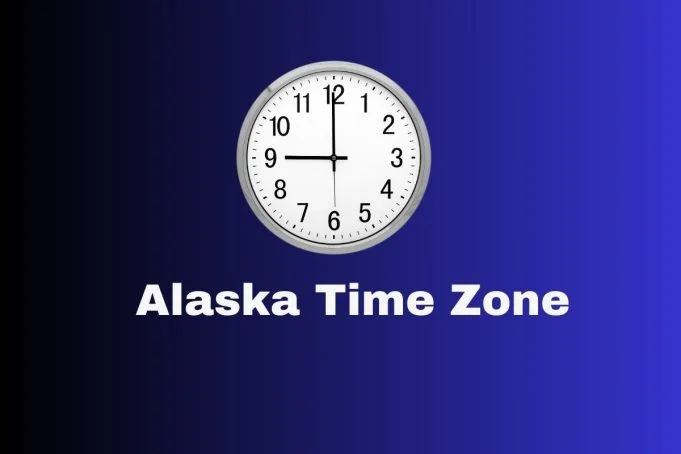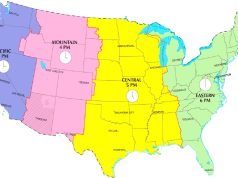Alaska is located in the Alaska Time Zone. So standard time is Alaska Standard Time (AKST) and daylight savings time is Alaska Daylight Time (AKDT).
The time zone for Alaska is nine hours behind Greenwich Mean Time (UTC/GMT -9). The time offset during daylight saving time is minus eight hours (UTC/GMT -8). This time zone uses the mean solar time of the 135th meridian west of the Greenwich Observatory as its reference point.
- Standard Time: Alaska Standard Time (AKST)
- Daylight Saving Time: Alaska Daylight Time (AKDT)
Changing from AKST to AKDT at 02:00 LST to 03:00 LDT on the second Sunday of March and returning at 02:00 LST to 01:00 LST on the first Sunday of November has been in effect since 2007.
What is The Time Zone?
A time zone is a geographic region on Earth that utilizes the same time. They are frequently predicated on national boundaries or lines of longitude. Greenwich Mean Time (GMT) is the mean solar time at the Royal Observatory in Greenwich, London, which is considered to be at zero degrees longitude.
Although Coordinated Universal Time (UTC) and Greenwich Mean Time (GMT) reflect the same time, GMT is a time zone while UTC is a time standard used as the basis for civil time and time zones around the world.
Although GMT once served as a time standard, it is now primarily used as a time zone in Africa and Western Europe. UTC, which is based on extremely accurate atomic clocks and the rotation of the Earth, is the current standard.
UTC is not dependent on daylight saving time (DST), although some countries change time zones during their DST period, such as the United Kingdom during British Summer Time.
The majority of time zones on land are offset from UTC. UTC divides time into days, hours, minutes, and seconds, whereas the Gregorian calendar defines days differently. In general, time zones are defined as a positive or negative integer number of hours to UTC, such as UTC-05:00, UTC+08:00, etc. The range of UTC offset is from UTC-12:00 to UTC+14:00.
In most cases, UTC is offset by an hour, but the offset can also be a half-hour or a quarter-hour, as in UTC+06:30 and UTC+12:45.
History of Alaska Time Zone
The history of the Alaska Time Zone is intertwined with the broader history of timekeeping and political changes in Alaska. Before the adoption of standardized time zones, local solar time was used in different locations, leading to a plethora of local times across regions. The introduction of time zones was primarily driven by the needs of railroads in the late 19th and early 20th centuries, which required standardized time to maintain schedules over long distances.
Early Period
Pre-1867: Before the purchase of Alaska from Russia by the United States in 1867, timekeeping was largely based on local solar time. Different communities might observe time differently based on the position of the sun.
Purchase by the United States and Initial Changes
1867 (Transfer of Alaska): When Alaska was transferred to the United States, the territory continued to use local meantime. As settlements and infrastructure grew, especially with the gold rushes at the end of the 19th century, the need for a more uniform time-keeping system became apparent.
Standard Time Zones
1883: The United States adopted standard time zones for the contiguous states, but Alaska, being geographically separated and less developed, was not immediately included in this system.
Early 20th Century: As telegraph, and later, radio communications developed in Alaska, the need for standardized time became more acute. Different regions of Alaska operated on their time standards, often based on the nearest significant economic center or transportation hub.
Alaska Standard Time Establishment
1942: During World War II, the U.S. government recognized the need for uniform timekeeping in Alaska, both for military and civilian purposes. This led to the establishment of the Alaska Time Zone, which covered the entire territory. The zone was set at GMT-10 hours.
1966: The Uniform Time Act of 1966 brought further standardization and introduced daylight saving time (DST) to Alaska, as it did to the rest of the United States. This meant Alaska would shift between Alaska Standard Time (AST) in the winter and Alaska Daylight Time (ADT) in the summer.
Adjustments and the Aleutian Islands
1983: Due to its vast size and the presence of the Aleutian Islands extending into the western hemisphere, portions of Alaska were moved to the Hawaii-Aleutian Time Zone (HAT). This zone is GMT-10 hours standard time, moving to GMT-9 with DST. The rest of Alaska remained on AST, which is GMT-9 hours, moving to GMT-8 with DST.
Recent Changes
The Alaska Time Zone has remained relatively stable in recent years. Legislative attempts and discussions about abolishing daylight saving time or making other adjustments occur periodically but haven’t resulted in significant changes.
The history of timekeeping in Alaska reflects the territory’s unique geographical and cultural development. From local solar time to standardized time zones, these changes have facilitated communication, travel, and economic activities in the state.
What is The Time Zone in Alaska?
Alaska is split between two time zones. The overwhelming majority of the land, including Anchorage, Juneau, and Fairbanks, lies within the Alaska Time zone. Due to the state’s observance of daylight savings time, two distinct timepieces are depending on the season.
Hawaii–Aleutian Time is only observed by the western islands of the Aleutian chain and St. Lawrence Island. Additionally, they observe daylight savings, so two distinct timepieces are depending on the season.
Alaska Time Zone Information

AKST or Alaska Standard Time has a UTC offset of -9 hours. This indicates that the time zone is nine hours behind UTC. The time zone is observed predominantly by North American territories (Alaska) during the winter months when Daylight Saving Time is not in effect. As soon as Daylight Savings Time begins — in the summer — certain areas transition to Alaska Daylight Time or AKDT.
| Country | United States |
| Alaska Capital Name | Juneau |
| Alaska Time Zone Name | Alaska Daylight Time |
| Time Zone Abbreviation | AKST |
| Time Zone Name | Alaska Standard Time |
| Time Offset | UTC/GMT-08:00 |
| Observe DST | Yes |
| Daylight Saving Time | +1 hour |
| Latitude | 61° 13′ 05″ North |
| Longitude | 149° 54′ 00″ West |
Daylight Saving Time in Alaska
Daylight Saving Time (DST) in Alaska is observed to maximize daylight during the summer months. Alaska follows the rules set by the Uniform Time Act, which allows for the adjustment of clocks to save daylight. Typically, DST in Alaska begins on the second Sunday in March when clocks are set forward by one hour, moving from Alaska Standard Time (AKST) to Alaska Daylight Time (AKDT).
This change results in longer evenings and more daylight for outdoor activities. DST in Alaska ends on the first Sunday in November when clocks are set back by one hour, returning to AKST. The purpose of DST is to conserve energy and make better use of daylight during the warmer months. Residents and visitors need to be aware of these time changes and adjust their schedules accordingly.
Is Alaska Divided Into Two Time Zones?
One hour behind the rest of the state, the western Aleutian Islands observe Hawaii-Aleutian Time. Alaska is the nation’s largest territory. It is larger than all but 18 nations and roughly one-fifth of the total land area of the 48 contiguous states.
Alaska’s territory spans nearly as much longitude as the continental United States, so the use of two time zones will inevitably result in inaccuracies. According to Alaska’s breadth, the state should have four time zones, but political considerations have resulted in only two.
Does Alaska Observe Daylight Saving Time?
Alaska observes Daylight Saving Time, where the time is advanced by one hour, resulting in an eight-hour difference from Greenwich Mean Time (GMT-8). After the summer months, the time is advanced by one hour, resulting in a 9-hour time difference with GMT.
Conclusion
The Alaska Time Zone holds a crucial position in the timekeeping system, serving as a reference point for the state’s residents and businesses. Its distinct offset from other time zones allows for adaptation to the region’s unique natural environment and daylight variations. Furthermore, Alaska Time plays a vital role in connecting Alaska with the rest of the world, facilitating international commerce, travel, and communication.
With its historical and cultural significance, the time zone stands as a symbol of Alaska’s heritage and resilience. Alaska Time remains an essential aspect of daily life and global connectivity for the region.
Frequently Asked Questions (FAQs)
What time zone is Alaska using?
Alaska Standard Time – Alaska is located in the remote northwest of North America and does not share a border with any other U.S. state. Alaska Standard Time (AKST) UTC − 9 h; Alaska Daylight (AKDT) UTC − 8 h.
How many time zones are in Alaska?
Alaska spans 57.5 degrees of longitude (four time zones), which is nearly identical to the 57.6 degrees between Maine and Washington; consequently, the “South 48” spans four time zones as well. Alaska incorporates the International Date Line, but this boundary is shifted to the edge of the Aleutian Islands by custom.
Does Alaska have hours or nights?
Despite being the largest state in the United States, Alaska has a small population. With 24 hours of daylight during the summer and 24 hours of darkness during the winter, Alaska is a strange and enigmatic place to many. Here are some misconceptions about the unusual daylight patterns of Alaska that have been debunked.
Is Alaska in the same time zone as New York?
Alaska has 2 time zones. Here, the time zone of the capital, Juneau, is observed. On Tuesday, May 16 at 7:00 a.m. in Alaska, it was 11:00 a.m. in New York. Alaska lags behind New York by four hours.
Is Alaska night and day at the same time?
Yes, under the appropriate conditions. Due to the earth’s inclination and the time of year, it is possible to see night and day at the same time in regions near the Arctic Circle. Alaska is located in the northwest corner of the West Coast of the United States, just across the Bering Strait from Asia.
How many time zones are in the USA?
With the Fall 2019 release of the National Transportation Atlas Database (NTAD), a new map of the nation’s time zones is included, depicting the geographical boundaries of four time zones in the continental United States and five additional time zones used in Alaska, Hawaii, and other U.S. territories.
What is Alaska known for?
Alaska is renowned for its vast wilderness, abundance of recreational activities, and Alaskan Native culture. Additionally, Alaska is one of the best locations in the world to view the Northern Lights. The 49th state, with its mountains, sea fjords, and extensive interior terrain, is a photographer’s paradise.
When did Alaska have 4 time zones?
In 1983, the relatively young state of Alaska spanned four time zones, dividing the state from Juneau to the Aleutians into a maze of various moments of the day, according to news reports and Alaska postcards.
Is Alaska a good place to live in?
The summers are amazing, but the winters are extremely harsh. It is a beautiful but primarily wild state. There are many excellent reasons to want to reside in Alaska, but each has a disadvantage. It can be a wonderful place to reside, but you must know what you’re getting yourself into.























![25 Best Peruvian Foods You Must Try In Peru [With Recipes] Peruvian Food](https://tourinplanet.com/wp-content/uploads/2024/07/Peruvian-Food-100x75.jpg)



![What is The Marvelous VFR C500? – [Key Features and Overview] Marvelous VFR c500](https://tourinplanet.com/wp-content/uploads/2024/07/Marvelous-VFR-c500-100x75.jpg)
